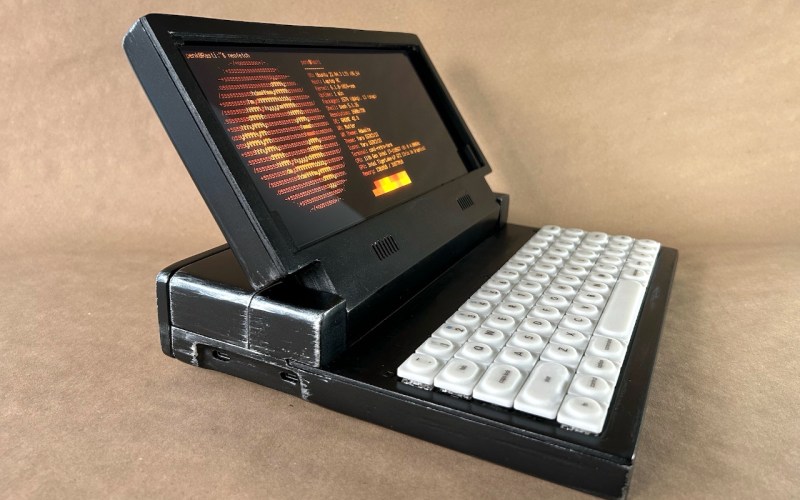Today, every laptop pretty much looks like every other laptop. Sure you might run into a few different colors and screen sizes out there, but on the whole, all the manufacturers have pretty much agreed on the basic shape and nobody is looking to rock the boat with something different.
Ah, but it wasn’t always so. Before the form factor we all recognize today took over, there were all sorts of interesting variations on the basic portable computer concept. For the Rasti, creator [Penk Chen] definitely took some inspiration from the iconic (and largely unobtanium) GRiD Compass of NASA and Aliens fame. But while its 3D printed case might look like a product of the early 1980s, on the inside, it features a Framework Laptop 13 mainboard using an 11th gen Intel CPU.
In addition to the widescreen 10.4 inch (1600 x 720) QLED display from Waveshare, the Rasti also includes a custom mechanical keyboard that’s actually been spun off into its own project. So even if you can’t swing building the whole Rasti, you could still find yourself tapping away on its vintage-styled input device.
Somewhat unsurprisingly, this isn’t the first time we’ve seen somebody 3D print a computer inspired by the GRiD Compass. The GRIZ Sextant we covered back in 2021 was another triumph that would be the envy of any hacker meetup.
















I really like this concept, and this build look really neatly finished too, really sells the look. Seems like they had the space but chose not to add the framework modular ports on one side – a mistake IMO as more IO is always nice and being able to fit the right IO for the jobs you do eliminates those annoying tangled piles of dongles you may be taking with you.
It is also nice to see a framework project from time to time. Much as I like the Pi family and can see a Pi4 or CM4 being way more than required in most portable builds (not yet tried the Pi5 – no reason to spend money on more performance yet when the Pi4’s are still proving perfectly acceptable) it is hard to argue against a framework mainboard on anything but price grounds.
I am wondering if this form factor would benefit from a screen that can tilt back a little bit more and some flick out feet on the bottom of the case – just to raise the screen into your eyeline a little more and tilt that keyboard a touch (not something I actually prefer in the keyboards I’ve had, but some folks do). Though in this case more about brining the screen up a little more than the keyboard angle, you just get one by doing the other…
Dissenting opinion: since all of the I/O modules are based on USB 3 anyway, it means that you have to get special (read: expensive) adapters instead of the generic (read: inexpensive) adapters. I’d much rather carry around a pencil box full of the dongles and adapters than choose which ports I’ll be limited to, due to their prices.
Rasti is also a brand of LEGO style toy blocks. For a moment I thought someone had made a computer out of those blocks.
I have a few older laptops, I believe it was Apple powerbooks that first moved the keyboard closer to the screen to provide a wrist rest. Now how many manufacturers are there for laptops vs companies rebadging products from Taiwan and China.
The Compass design just never grows old. Add to that the distressing job that makes this look like it could actually BE a 1980s laptop just adds to the charm. Very well executed project.
+1 for showing it with an all-orange display!
This looks amazing, netbooks really need to make a comeback. I’ve always wanted to see the concept done with something like a narrow pelican case, just the right size for this type of screen and keyboard, to be about half the volume of a regular laptop (well thicker) but also practically indestructible when closed… not that I’d take it camping, but it’d be nice to just throw in any bag without thinking.
Which is actually what I do now with my 10″ GPD Win Max 2, and a thin pelican case which is itself about the size of a chonky 14″ laptop. But one of these narrow widescreen displays with a decent low profile mechanical keyboard (and even something like the N100 if a high end framework mobo is overkill, it can still use the USB-C modules) in the smallest possible but rugged-ish and utilitarian package would sell like hotcakes if any company developed it. Probably.